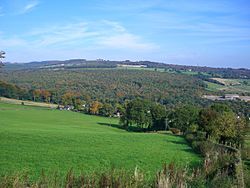Beeley Wood facts for kids
Quick facts for kids Beeley Wood |
|
|---|---|

Beeley Wood seen from the south-west across the upper Don valley
|
|
| Lua error in Module:Location_map at line 420: attempt to index field 'wikibase' (a nil value). | |
| Type | woodland |
| Location | City of Sheffield, South Yorkshire, England |
Beeley Wood is a beautiful forest in the north of Sheffield, England. It's close to a place called Middlewood. This wood is special because it's one of 35 "ancient woodlands" in Sheffield. An ancient woodland means it has been a forest continuously since the year 1600 or even earlier!
Contents
Exploring Beeley Wood
Beeley Wood sits on the eastern side of the River Don. It's located between the village of Oughtibridge and the Sheffield area of Middlewood. You can often enter the wood from Clay Wheels Lane or by crossing the Don River using the Rocher footbridge.
The wood covers about 60 hectares (148 acres). It slopes quite steeply up from the river. The land rises by about 70 meters (230 feet) before reaching farmland at the top.
There are two main public footpaths in the wood. One is a lovely riverside walk. It's part of the Upper Don Walk. This path follows the river from central Sheffield to Oughtibridge. The other path runs along the highest part of the wood. Many other smaller paths are also there.
The famous Woodhead railway line also crosses Beeley Wood. There's a level crossing and a footbridge for people to get across the tracks safely.
Wildlife and Nature
Beeley Wood is home to lots of amazing wildlife. A large group of bats lives here. You can also spot all three types of woodpeckers that live in Britain. In spring, the forest floor is covered with beautiful bluebells.
Just northeast of Beeley Wood is a smaller area called Wilson Spring Wood. It's also an ancient woodland. It's separated from the main wood by some farmers' fields.
A Look Back: History of Beeley Wood
The first time Beeley Wood was written about was in a document from 1161. This document allowed monks from Ecclesfield Priory to let their sheep graze there. This large wood stretched from Birley Edge down to the River Don. Beeley Wood is a part of that original big forest. A section of it is still called Priory Wood today.
In that old document, the wood was called "BYLLHAUWODE." This name comes from two old English words. They mean "Billa's enclosure." This suggests the wood was once connected to an Anglo-Saxon farm owned by someone named Billa.
Later, in 1332, another document mentioned Beeley Wood. It was listed as a place where people could graze their animals. However, by the 1500s, Beeley Wood became a "coppice" wood. This means trees were cut back regularly to encourage new growth. Grazing animals was not allowed as much then.
Changes Over Time
By the 1890s, coppicing in Beeley Wood started to stop. It wasn't as profitable anymore. The wood was allowed to grow into a "high forest." This meant the strongest new shoots from cut trees were allowed to grow into full-sized trees.
Many old or sick trees were removed around this time. They were replaced with young trees that weren't originally from Sheffield. These included beech, sweet chestnut, common lime, and sycamore.
In 1898, the Duke of Norfolk's forester planted many timber trees in Beeley Wood. These included ash, elm, sycamore, birch, lime, sweet chestnut, and beech. The young trees came from a nursery in Cheshire.
In 2011, the Forestry Commission started a five-year plan for the wood. They wanted to improve the habitat. Part of the plan was to restart coppicing in some areas. They also thinned out other parts. This lets more light and warmth reach the ground. This helps wildflowers, insects, and birds thrive.
More recently, in 2016, the Environment Agency removed part of a weir on the River Don. This helps fish move freely along the river. It also helps the river return to a more natural state.
Industry in Beeley Wood's Past
Today, Beeley Wood looks like a peaceful forest. But it was once a busy industrial area! Mining and quarrying used to happen here.
Mining for Ganister
Workers mined a material called Ganister. This is a very hard type of sandstone. It was used to make special bricks called silica bricks. These bricks lined industrial furnaces, which are like giant ovens.
Because the wood is on a slope, miners used a method called Drift mining. This meant they dug tunnels into the hillside. These tunnels went deep underground. The slope also helped them move the Ganister. They used gravity trackways to slide the material down to the valley floor.
Ganister was also quarried in at least one spot in the woods. You can still see the overgrown remains of a large quarry today. The biggest mine was the Beeley Wood Mine. It employed over 30 workers and 12 ponies in the 1920s and 1930s! In recent years, the Coal Authority has checked and fenced off old mine shafts to keep people safe.
Other Local Industries
There were other industries on the edge of Beeley Wood, near Middlewood. The Beeley Wood Works is one example. It dates back to 1749! It was once called the Nova Scotia Tilt Company. Today, the Abbey Stainless Steel Company uses the site.
For many years, a large Union Carbide factory was also in this area. It made carbon electrodes for the steel industry. It also made graphite rods for the nuclear industry. This factory closed several years ago. In 1976, it employed 850 people!
In 2009, the old factory site got permission to become a "Recycling Village." A company called Ballast Phoenix Ltd. now recycles ash from Sheffield's main Energy from Waste incinerator there.
Images for kids


